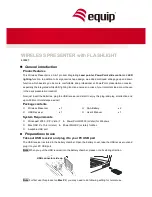
Triggered acquisition - burst of frames
For more information please see:
Frame Burst Start
In this mode each trigger pulse triggers defined number of exposed frames.
Figure 55: triggered burst of frames – frame burst start
Exposure defined by trigger pulse length
In this mode the exposure is defined by trigger pulse length. This can be used to achieve longer exposure than allowed by
. Also, it can
be used to trigger several images in sequence with different exposure time. Exposure time is measured and reported in image metadata.
Please see:
Exposure Defined by Trigger Pulse Length
Figure 56: exposure defined by trigger pulse length
3.3
Exposure time
Also known as shutter speed. This parameter defines the length of the integration period for each frame. Most
sensors generate the
exposure interval internally. For some it is possible to control it by external signaling. The sensor internal timing depends on the provided
system clock. Most sensors use dividers to generate slower clocks for internal usage.
The minimum exposure time is defined mostly by row times, where the row time (T
R
) is dependent on various internal settings. Very few
sensors support exposure times equal to zero. There is a defined minimum exposure time as well as minimum steps between possible
exposure times. There is also a maximum exposure time, defined by sensor architecture.
3.4
Gain
The gain value influences the analog-to-digital conversion process of the image sensor pipeline and acts as a multiplier of the output signal.
Using gain values greater than 0 will increase the pixel intensities but may also increase the overall noise level. For some camera models
the gain can be set in discrete steps only.
XIMEA Technical Manual, Version: v230927
57
















































